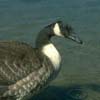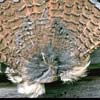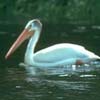Birds
 The forest, from its floor and its shrubs to the limbs and highest peaks of its trees, is the meeting, breeding, incubation, and birth place of hundreds of species of the world's bird population. It is the nesting place for the rarest of birds, such as the whooping crane, and for thousands of migratory waterfowl, shorebirds, songbirds, hawks, eagles or upland birds. It is the year-round home of snowbirds, ravens, whiskeyjacks, and four types of grouse. Birds without a forest are birds without a means to sustain their own species.
The forest, from its floor and its shrubs to the limbs and highest peaks of its trees, is the meeting, breeding, incubation, and birth place of hundreds of species of the world's bird population. It is the nesting place for the rarest of birds, such as the whooping crane, and for thousands of migratory waterfowl, shorebirds, songbirds, hawks, eagles or upland birds. It is the year-round home of snowbirds, ravens, whiskeyjacks, and four types of grouse. Birds without a forest are birds without a means to sustain their own species.
-
-Terry Garvin, from Carving Faces, Carving Lives: People of the Boreal Forest
The boreal forest is the home to over three hundred species of birds. A majority of these bird species are migratory, and so are only present in the boreal forest during the summer months when they nest and breed and raise their young. Migratory birds can fall into two main groups: short distance migrants, or those birds that only migrate as far south as the United States; and long-distance migrants, or those birds that spend their winters in tropical climates. Short distance migrants include such species as robins, blue herons, eagles, crows, wrens, and several types of sparrows. Long distance migrants include peregrine falcons, warblers, ruby–throated hummingbirds, and swallows.
 With the coming of the autumn, the skies over the forest canopy fill with flocks of migratory birds winging south to a more favourable climate. The remaining bird species that have adapted ways to survive the long winter months number somewhere between twenty and thirty. This number is reduced even more in the northern stretches of the boreal forest. These year-long residents of the boreal forest include nuthatches, chickadees, ravens, and several species of owls.
With the coming of the autumn, the skies over the forest canopy fill with flocks of migratory birds winging south to a more favourable climate. The remaining bird species that have adapted ways to survive the long winter months number somewhere between twenty and thirty. This number is reduced even more in the northern stretches of the boreal forest. These year-long residents of the boreal forest include nuthatches, chickadees, ravens, and several species of owls.
Traditional Uses:
Birds were of great value to northwest Aboriginal Peoples as a source of food and materials for crafting useful items, and were hunted and snared for this purpose. While birds did not make up the main part of the northern Aboriginal diet, bird meat and eggs were a valued source of food if other foods were not readily available. Bird fat was used for cooking, while bird carcasses served as bait to trap animals.
 Large waterfowl like loons, geese, and pelicans were valuable not only for their meat, eggs, and fat, but for their skins, which, if removed from the bird carcass properly, could make waterproof bags for the storage of items that needed to be kept dry. The pouch beneath a pelican’s bill also served this purpose, while grouse gullets were dried and tied off for use as baby rattles. The down feathers of waterfowl like ducks and geese were useful as stuffing for pillows, parkas, and quilts. Feathers of all types of birds could be used as decorations to be applied to clothing and artworks.
Large waterfowl like loons, geese, and pelicans were valuable not only for their meat, eggs, and fat, but for their skins, which, if removed from the bird carcass properly, could make waterproof bags for the storage of items that needed to be kept dry. The pouch beneath a pelican’s bill also served this purpose, while grouse gullets were dried and tied off for use as baby rattles. The down feathers of waterfowl like ducks and geese were useful as stuffing for pillows, parkas, and quilts. Feathers of all types of birds could be used as decorations to be applied to clothing and artworks.





